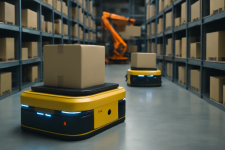
Fulfillment has never been easy. But today, it’s a different kind of hard. Tariffs are rising. Carrier rate hikes have become the norm. Delivery expectations keep tightening. And brands don’t get much margin for error.
You can’t just set your ops plan once a year and let it run on auto-pilot. If you’re not adapting in real time, and faster than the market shifts, you’re falling behind. That’s where AI is starting to quietly change how smart brands move.
Not with hype. Not with magic. Just with more visibility and faster, smarter decisions when they matter most.
Smarter Fulfillment Starts with Smarter Decisions
Traditional order routing is blunt: you assign a fulfillment center based on the nearest zone, and that’s it. But in reality, conditions change constantly: carrier delays, weather events, surcharges, inventory levels, duty and tariff shifts.
AI-driven order routing gives operators more flexibility. It factors in both cost and service – not once a quarter, but every time an order hits the system.
That’s the level of adaptability brands need now, and the ones building it into their fulfillment flow are the ones keeping customers happy even when chaos hits.
Predictive Inventory Placement: Staying Ahead of Demand
Forecasting inventory used to be like driving with your eyes glued to the rearview mirror…you’d guess based on last year’s data with this year’s growth plan.
Today, predictive inventory placement uses AI models to analyze marketing calendars, ad campaigns, trends, port congestion, and even weather patterns, giving brands a forward-looking view of where demand is increasing or decreasing.
Let’s say you’re an apparel brand with a high SKU count. It’s not realistic to split your entire inventory across multiple locations – but with the right tooling, you don’t have to. You can strategically split just your top-performing SKUs, avoiding the inefficiencies and costs that come with split shipments or poorly placed inventory.
This level of intelligent inventory placement lets you take advantage of a multi-node fulfillment network – something that wasn’t really feasible before due to the complexity and manual effort involved. With automation and smart systems in place, you can now scale efficiently while minimizing errors. Brands that still allocate inventory manually are burning cash on dead stock and missed sales. Predictive placement will become the baseline for staying agile.
Carrier Selection: Where AI Moves the Needle
Carrier and method selection is where a lot of brands quietly lose money and customer trust. And picking a carrier isn’t just about the cheapest rate anymore. It’s about who’s actually delivering on time, who’s navigating customs cleanly, and who’s handling increased parcel volumes without collapse –not to mention packaging selection and other ways you can increase your costs inadvertently.
Automated carrier selection gives brands live intelligence: How are delivery times trending in a certain region? Where are congestion risks popping up? Which carriers are suddenly missing SLAs?
For instance, if a carrier’s on-time performance in the Southeast drops by 15%, AI can detect the issue early and automatically reroute orders to a more reliable carrier preventing delays before more customers are impacted. It can also identify exactly where in the transit process the breakdown is happening.
We’ve seen firsthand how powerful this is. Leaning on dynamic carrier optimization isn’t just saving merchants a few cents per shipment, it’s defending customer experience in an environment where a 48-hour delay can mean a lost customer and future sales.
Without automation, you’re just guessing and being reactive. With it, you’re making moves backed by live data, and it shows in your NPS scores and bottom line.
Automation Isn’t Hype, It’s Table Stakes
There’s no shortage of big promises around AI and automation. But in fulfillment, the application is simple: faster, smarter decisions when the market shifts.
No model is perfect. You still need humans who know logistics inside and out. But AI is like an extra 20 sets of eyes scanning risk signals and nudging smarter choices 24/7.
It’s all about building resilience when everything around you is unstable.
Fulfillment Is Now a Growth Strategy
Years ago, fulfillment was a back-office conversation. Today, it’s front and center for every brand that wants to grow. Faster, smarter fulfillment doesn’t just save on shipping costs, it drives conversion rates, improves retention, unlocks expansion into new regions, and protects cash flow when tariffs or surcharges spike.
If your fulfillment network can’t flex dynamically, you’re paying for it — in both costs and customer experience. And your customers won’t wait around while you figure it out.
Brands investing in smarter fulfillment systems, combining real-time data, automation, and human judgment, are setting themselves up to not just survive the next disruption, but gain ground while others scramble.
What’s Next: How Automation Will Keep Pushing Fulfillment Forward
AI in fulfillment isn’t slowing down. Here’s what’s around the corner:
- Smarter returns management: Predict likely returns at the SKU level and adjust listing info or sizing recommendations pre-shipment to cut reverse logistics costs.
- Real-time inventory rebalancing: Dynamically shift stock across nodes based on live sales patterns, not quarterly reviews.
- SKU risk modeling: Identify dead stock early, liquidate it faster, and protect warehouse space and working capital.
- Performance management: AI monitors critical activities and pinpoints opportunities to improve efficiency.
Every one of these use cases boils down to the same idea: faster insights, faster pivots, better outcomes.
Brands that automate their logistics stack are building supply chains that flex when others break. That’s what separates the brands growing through disruption from the ones getting buried by it.
The post How Automation Is Quietly Reshaping Ecommerce Fulfillment appeared first on Unite.AI.



